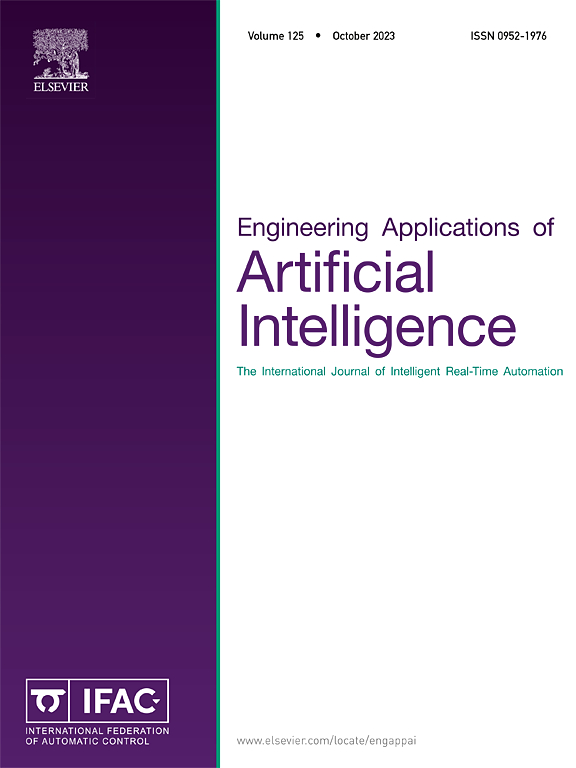Myocardial ischemic classification using a knowledge-guided polar transformer in two-dimensional echocardiography
IF 8
2区 计算机科学
Q1 AUTOMATION & CONTROL SYSTEMS
Engineering Applications of Artificial Intelligence
Pub Date : 2025-07-25
DOI:10.1016/j.engappai.2025.111871
引用次数: 0
Abstract
Myocardial ischemia, characterized by inadequate blood supply to the heart muscles, is critical to cardiovascular diseases. Timely and accurate identification of ischemic segments is essential for prompt intervention and patient care. This study developed a Transformer-based model to identify myocardial ischemia in left ventricle short-axis (LVSA) two-dimensional echocardiography (2DE) images where a novel Knowledge-Guided Polar Transformer (KGPT) was proposed that integrated the unique characteristics of 2DE images with the prior clinical knowledge. 305 patients (aged 57.6 ± 8.8 years) were selected and underwent transthoracic echocardiography within 1–3 days prior to invasive coronary angiography (ICA). With ICA and quantitative flow ratio as the gold standard of myocardial ischemia, the KGPT model was trained to classify the LVSA 2DE images as ischemia or non-ischemia by capturing spatial features in a radial orientation. Its performance was evaluated with five-fold cross-validation and receiver operating characteristic curve (ROC) analysis. It achieved an area under ROC (AUC) of 0.8326 ± 0.0906, with an accuracy of 79.50 ± 5.40 %, precision of 79.07 ± 6.70 %, recall of 80.79 ± 7.87 %, and F1 score of 78.43 ± 6.56 %. In comparison, the original Swin-Transformer model produced an AUC of 0.7011 ± 0.0334, accuracy of 70.20 ± 1.04 %, precision of 68.58 ± 3.12 %, recall of 63.21 ± 3.60 %, and F1 score of 63.13 ± 3.78 %. The differences were statistically significant (P < 0.05). The KGPT also demonstrated significantly superior performance to radiologists. It effectively classifies ischemic regions in 2DE images, presenting a promising tool for diagnosing myocardial ischemia. The integration of clinical knowledge with Transformer enhances the accuracy and reliability of ischemia classification, potentially revolutionizing the diagnosis and monitoring of myocardial ischemic diseases.
在二维超声心动图中使用知识引导的极性变压器进行心肌缺血分类
心肌缺血,以心肌供血不足为特征,是心血管疾病的关键。及时准确地识别缺血节段对于及时干预和患者护理至关重要。本研究建立了一种基于变压器的模型来识别左心室短轴(LVSA)二维超声心动图(2DE)图像中的心肌缺血,并提出了一种新的知识引导的极性变压器(KGPT),该模型将2DE图像的独特特征与先前的临床知识相结合。305例患者(年龄57.6±8.8岁)在有创冠状动脉造影(ICA)前1-3天行经胸超声心动图检查。以ICA和定量流量比作为心肌缺血的金标准,训练KGPT模型,通过在径向方向上捕获空间特征,将LVSA 2DE图像划分为缺血或非缺血。采用五重交叉验证和受试者工作特征曲线(ROC)分析对其进行评价。其ROC下面积(AUC)为0.8326±0.0906,准确率为79.50±5.40%,精密度为79.07±6.70%,召回率为80.79±7.87%,F1评分为78.43±6.56%。相比之下,原swan - transformer模型的AUC为0.7011±0.0334,准确率为70.20±1.04%,精密度为68.58±3.12%,召回率为63.21±3.60%,F1评分为63.13±3.78%。差异有统计学意义(P <;0.05)。KGPT也表现出明显优于放射科医生的表现。它能有效地对2DE图像中的缺血区域进行分类,为心肌缺血的诊断提供了一种很有前景的工具。临床知识与Transformer的整合提高了缺血分类的准确性和可靠性,可能会给心肌缺血性疾病的诊断和监测带来革命性的变化。
本文章由计算机程序翻译,如有差异,请以英文原文为准。
求助全文
约1分钟内获得全文
求助全文
来源期刊

Engineering Applications of Artificial Intelligence
工程技术-工程:电子与电气
CiteScore
9.60
自引率
10.00%
发文量
505
审稿时长
68 days
期刊介绍:
Artificial Intelligence (AI) is pivotal in driving the fourth industrial revolution, witnessing remarkable advancements across various machine learning methodologies. AI techniques have become indispensable tools for practicing engineers, enabling them to tackle previously insurmountable challenges. Engineering Applications of Artificial Intelligence serves as a global platform for the swift dissemination of research elucidating the practical application of AI methods across all engineering disciplines. Submitted papers are expected to present novel aspects of AI utilized in real-world engineering applications, validated using publicly available datasets to ensure the replicability of research outcomes. Join us in exploring the transformative potential of AI in engineering.
 求助内容:
求助内容: 应助结果提醒方式:
应助结果提醒方式:


